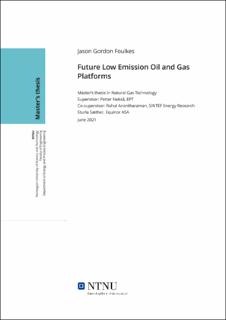| dc.description.abstract | This thesis investigates the use of energy-efficient technologies to reduce the quantity of CO2 emitted by offshore platforms. To do this, an offshore oil and gas platform is modelled on a process simulation software called Aspen HYSYS.
The main emissions from offshore platforms arise from the use of gas turbines, which accounts for 85 % of the total emissions on the Norwegian Continental Shelf (NCS). Thus, the focus of this analysis was to investigate methods to recover waste energy on a typical platform on the NCS and to make the power generation units more efficient and emit fewer quantities of CO2. A review of exergy analyses, conducted over the processing facility solely, recognised the production manifold, the recompression, and gas treatments trains as the largest sources of exergy destruction. Aside from energy losses within the processing system, the gas turbine exhaust gas was viewed as the most substantial waste stream on the platform. To recover and prevent the aforementioned losses, technologies such as bottom cycling, multi-phase expanders, waste heat CO2 Rankine cycles, H2 fuel blending, and wind energy are suggested.
The model was based on two platforms that are currently in operation on the NCS, Platform A and B. After development, the model was validated against real data for both scenarios. In each case, minimal deviations were illustrated. Hence, the output data from the model was deemed to be accurate. To compare the various impacts of the model modifications, key performance indicators (KPIs) were defined. These focused on the carbon footprint, energy efficiency, and operational costs (CO2 tax and fuel cost).
To analyse the model, a platform lifespan scenario was developed. This was based on Platform B and was extended over a 30-year duration. Several combinations of the aforementioned technologies were analysed. Within the context of this platform, the use of steam bottoming cycles, H2 fuel and wind energy was shown to be the most effective. Using these systems, a low emission scenario was developed. For the first 15 years of operation, a smaller more efficient gas turbine with a steam bottoming cycle and wind energy was implemented. Following the fifteenth year, H2 fuel was introduced, and the blend fraction was increased from 50 molar % to 90 molar % in the last period analysed. Over the entire 30-year lifespan, compared to the worst case, this scenario reduced CO2 emissions by 2.7 Mtonnes and saved 6.0 billion NOK, translating to a 54 % and 48 % reduction respectively.
For further work on this topic, the addition of KPIs which consider capital cost and platform weight is recommended. Aside from this, an investigation into the use of a central power distribution hub is suggested. | |
